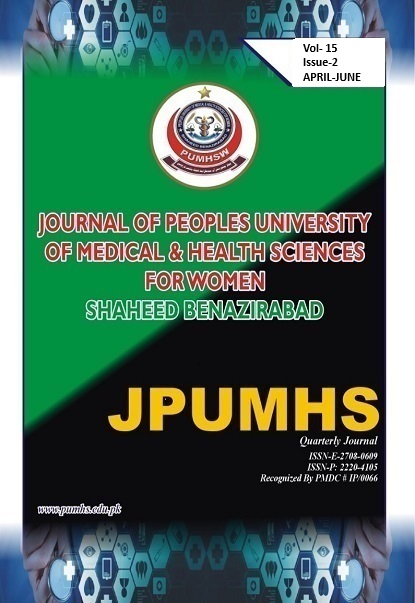PREVALENCE AND RISK FACTORS OF SURGICAL SITE INFECTIONS FOLLOWING ELECTIVE GENERAL SURGERY PROCEDURES.
J Peop Univ Med Health Sci. 2025:15(2), 05-12. http://doi.org/10.46536/jpumhs/2025/15.02.618
Keywords:
SSI, surgery, risk factors, prevalence, diabetes, obesity., SSI, surgery, risk factors, prevalence, diabetes, obesity.Abstract
BACKGROUND: In low- and middle-income countries like Pakistan, surgical site infections (SSIs)
result in increased health care expenditures, prolonged hospital stays, and increased morbidity.
Establishing successful preventive measures requires identifying region-specific risk factors and
prevalences. OBJECTIVE: To assess the prevalence of surgical site infections and identify
associated risk factors among patients who undergo elective general surgical procedures in a tertiary
care hospital. METHODS: It was a prospective observational study conducted between July 2023
and December 2024 at Hayatabad Medical Complex (HMC), Peshawar. There were 398 patients who
underwent elective general surgery procedures during the study period. The elective surgeries
involved were not emergency surgeries but they were scheduled to take place and occurred in sterile
conditions. Amongst the total, 18 patients were lost to followup. RESULTS: Of all the procedures,
172 (45.3%) were laparoscopic and 208 (54.7%) were open surgery. The most common surgeries
were appendectomy (14.5%), laparoscopic cholecystectomy (26.3%), and hernia repair (28.2%).
Based on wound classification, 238 cases (62.6%) were clean, 115 cases (30.3%) were clean
contaminated, and 27 cases (7.1%) were contaminated. Overall, the SSI rate was observed in
42(11.1%,) patients. Amongst which 28(7.4%) were superficial infections, 4(1.1%) organ/space
infections, and 10(2.6%) deep incisional infections. CONCLUSION: In elective general surgery,
SSIs play a significant role as postoperative complications and there are several modifiable risk
factors. Targeting procedures such as improved preoperative risk stratification, glycemic control,
weight reduction, consistent aseptic technique, may decrease the incidence of SSI and improve the
overall surgical experience.
Downloads
Downloads
Published
How to Cite
Issue
Section
License

This work is licensed under a Creative Commons Attribution-NoDerivatives 4.0 International License.




